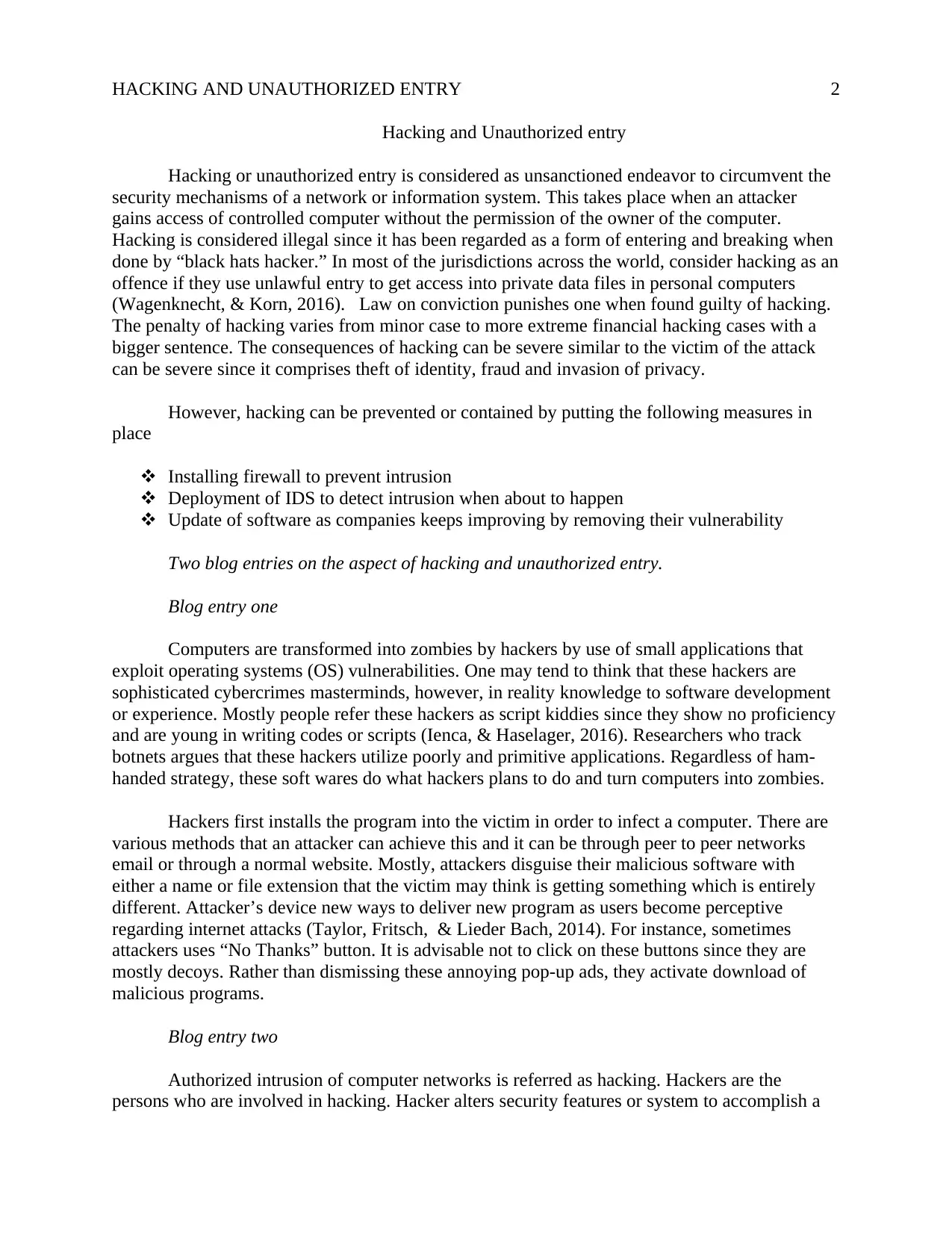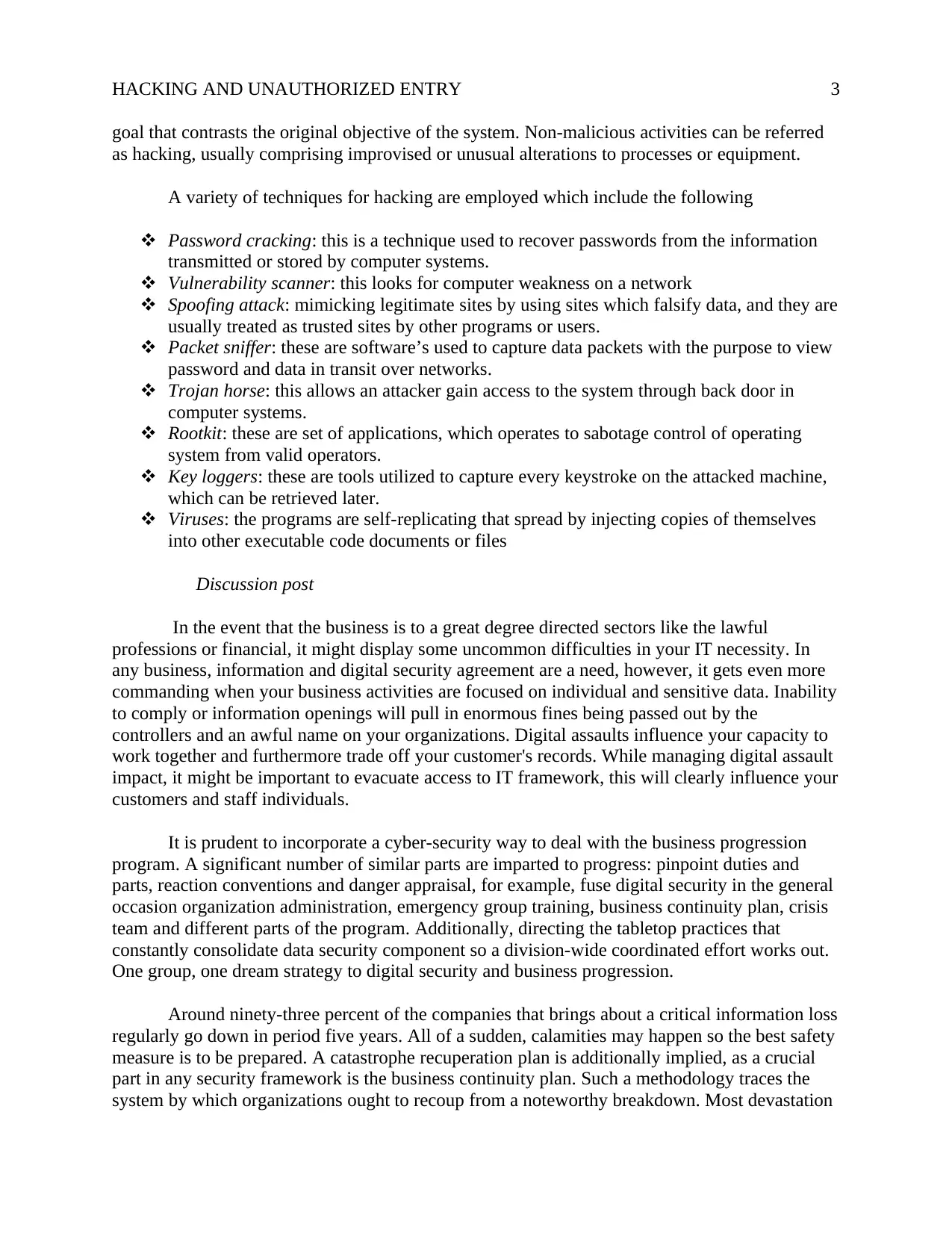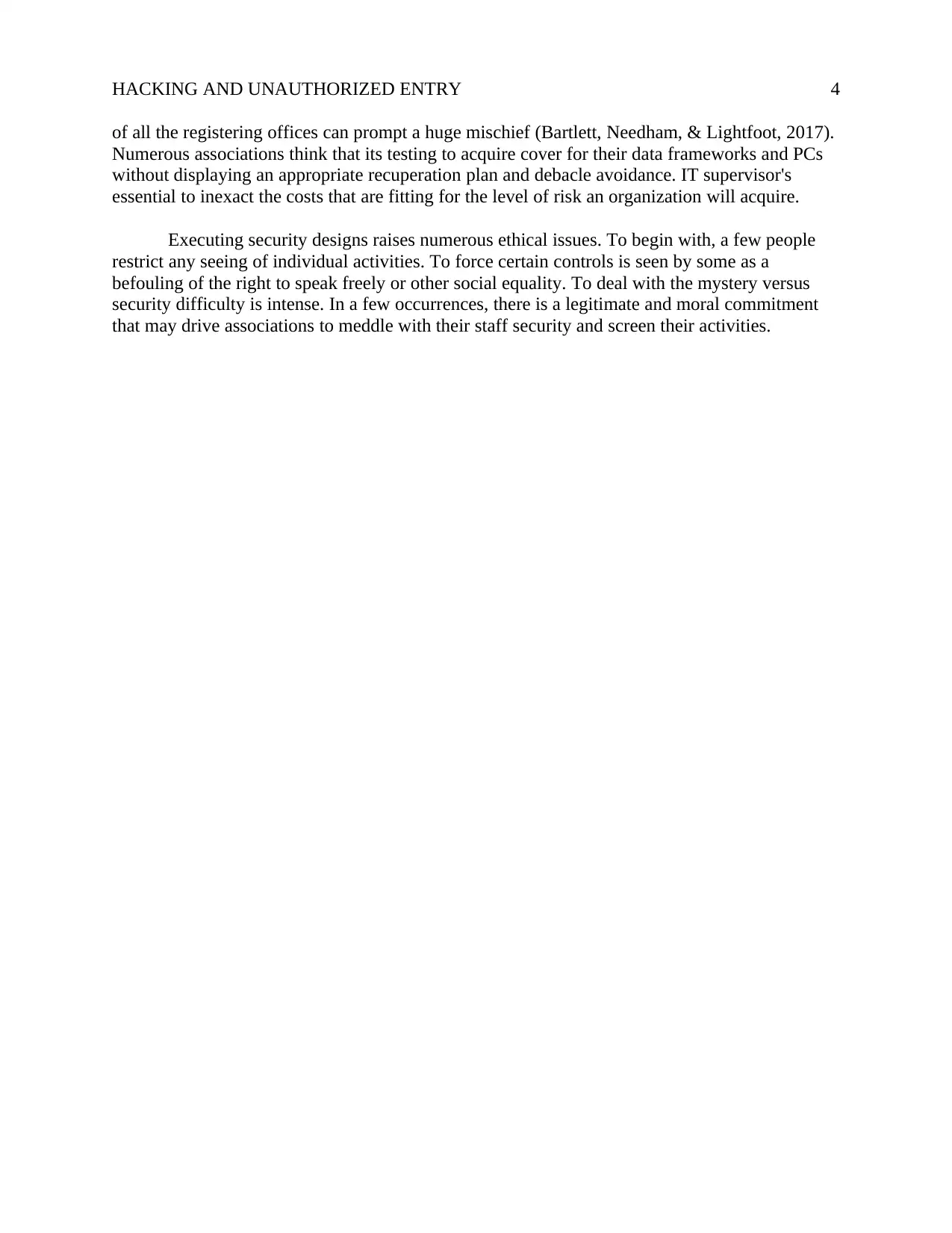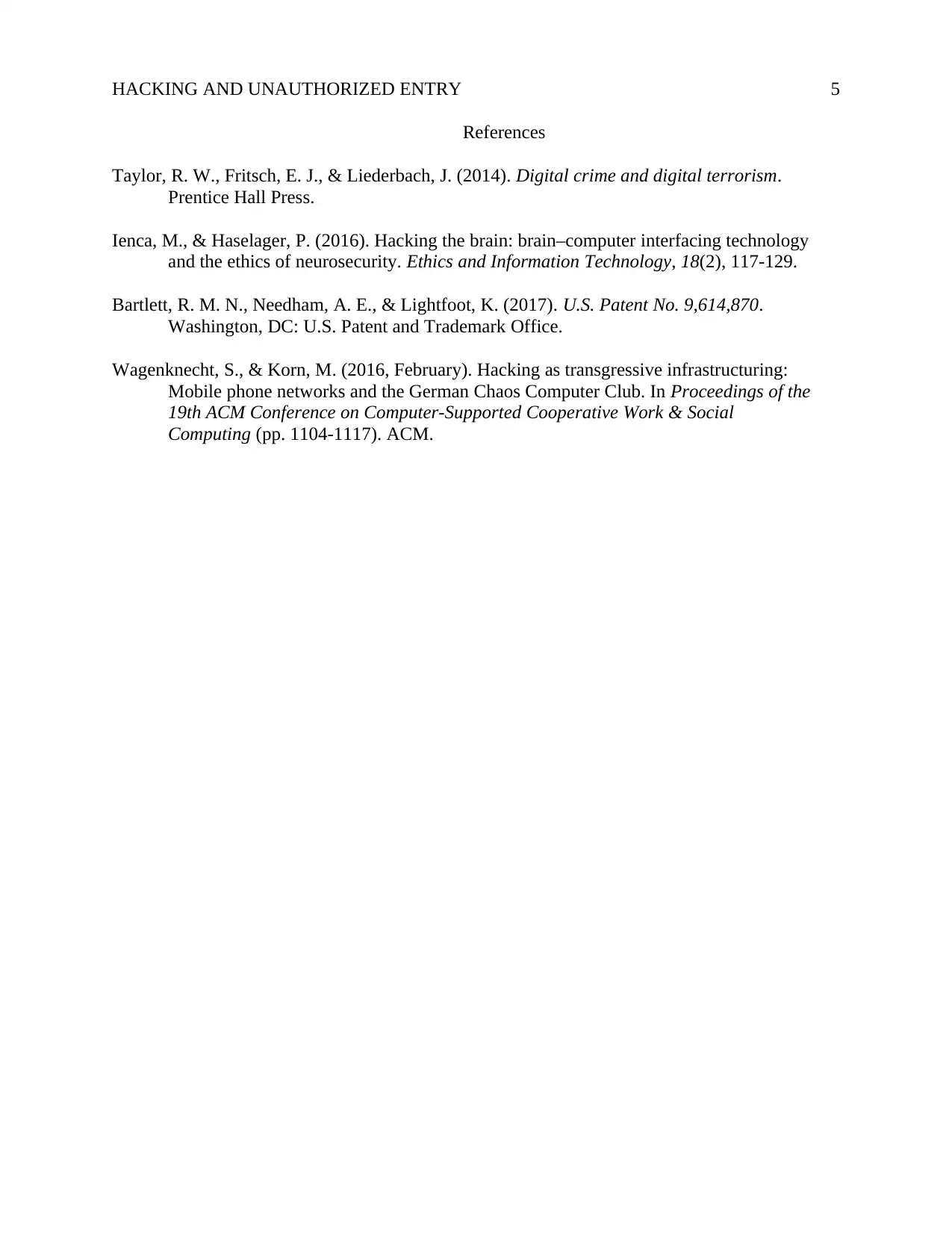Hacking and Unauthorized Entry: Analysis of Security Threats
VerifiedAdded on 2021/06/17
|5
|1343
|68
Homework Assignment
AI Summary
This assignment explores the concepts of hacking and unauthorized entry, defining them as illegal circumvention of security mechanisms to access computer systems without authorization. It includes two blog entries detailing how hackers use software vulnerabilities to transform computers into zombies and various hacking techniques such as password cracking, vulnerability scanning, and spoofing attacks. The assignment also presents a discussion post addressing the IT requirements for highly regulated sectors, emphasizing the importance of digital security, business continuity, and disaster recovery plans. It touches on ethical issues related to security implementation, such as privacy versus security, and the need for organizations to balance these considerations. The assignment references several academic sources to support its claims and analyses.

Running Header: HACKING AND UNAUTHORIZED ENTRY
Name
Institution
Date
Name
Institution
Date
Paraphrase This Document
Need a fresh take? Get an instant paraphrase of this document with our AI Paraphraser

HACKING AND UNAUTHORIZED ENTRY 2
Hacking and Unauthorized entry
Hacking or unauthorized entry is considered as unsanctioned endeavor to circumvent the
security mechanisms of a network or information system. This takes place when an attacker
gains access of controlled computer without the permission of the owner of the computer.
Hacking is considered illegal since it has been regarded as a form of entering and breaking when
done by “black hats hacker.” In most of the jurisdictions across the world, consider hacking as an
offence if they use unlawful entry to get access into private data files in personal computers
(Wagenknecht, & Korn, 2016). Law on conviction punishes one when found guilty of hacking.
The penalty of hacking varies from minor case to more extreme financial hacking cases with a
bigger sentence. The consequences of hacking can be severe similar to the victim of the attack
can be severe since it comprises theft of identity, fraud and invasion of privacy.
However, hacking can be prevented or contained by putting the following measures in
place
Installing firewall to prevent intrusion
Deployment of IDS to detect intrusion when about to happen
Update of software as companies keeps improving by removing their vulnerability
Two blog entries on the aspect of hacking and unauthorized entry.
Blog entry one
Computers are transformed into zombies by hackers by use of small applications that
exploit operating systems (OS) vulnerabilities. One may tend to think that these hackers are
sophisticated cybercrimes masterminds, however, in reality knowledge to software development
or experience. Mostly people refer these hackers as script kiddies since they show no proficiency
and are young in writing codes or scripts (Ienca, & Haselager, 2016). Researchers who track
botnets argues that these hackers utilize poorly and primitive applications. Regardless of ham-
handed strategy, these soft wares do what hackers plans to do and turn computers into zombies.
Hackers first installs the program into the victim in order to infect a computer. There are
various methods that an attacker can achieve this and it can be through peer to peer networks
email or through a normal website. Mostly, attackers disguise their malicious software with
either a name or file extension that the victim may think is getting something which is entirely
different. Attacker’s device new ways to deliver new program as users become perceptive
regarding internet attacks (Taylor, Fritsch, & Lieder Bach, 2014). For instance, sometimes
attackers uses “No Thanks” button. It is advisable not to click on these buttons since they are
mostly decoys. Rather than dismissing these annoying pop-up ads, they activate download of
malicious programs.
Blog entry two
Authorized intrusion of computer networks is referred as hacking. Hackers are the
persons who are involved in hacking. Hacker alters security features or system to accomplish a
Hacking and Unauthorized entry
Hacking or unauthorized entry is considered as unsanctioned endeavor to circumvent the
security mechanisms of a network or information system. This takes place when an attacker
gains access of controlled computer without the permission of the owner of the computer.
Hacking is considered illegal since it has been regarded as a form of entering and breaking when
done by “black hats hacker.” In most of the jurisdictions across the world, consider hacking as an
offence if they use unlawful entry to get access into private data files in personal computers
(Wagenknecht, & Korn, 2016). Law on conviction punishes one when found guilty of hacking.
The penalty of hacking varies from minor case to more extreme financial hacking cases with a
bigger sentence. The consequences of hacking can be severe similar to the victim of the attack
can be severe since it comprises theft of identity, fraud and invasion of privacy.
However, hacking can be prevented or contained by putting the following measures in
place
Installing firewall to prevent intrusion
Deployment of IDS to detect intrusion when about to happen
Update of software as companies keeps improving by removing their vulnerability
Two blog entries on the aspect of hacking and unauthorized entry.
Blog entry one
Computers are transformed into zombies by hackers by use of small applications that
exploit operating systems (OS) vulnerabilities. One may tend to think that these hackers are
sophisticated cybercrimes masterminds, however, in reality knowledge to software development
or experience. Mostly people refer these hackers as script kiddies since they show no proficiency
and are young in writing codes or scripts (Ienca, & Haselager, 2016). Researchers who track
botnets argues that these hackers utilize poorly and primitive applications. Regardless of ham-
handed strategy, these soft wares do what hackers plans to do and turn computers into zombies.
Hackers first installs the program into the victim in order to infect a computer. There are
various methods that an attacker can achieve this and it can be through peer to peer networks
email or through a normal website. Mostly, attackers disguise their malicious software with
either a name or file extension that the victim may think is getting something which is entirely
different. Attacker’s device new ways to deliver new program as users become perceptive
regarding internet attacks (Taylor, Fritsch, & Lieder Bach, 2014). For instance, sometimes
attackers uses “No Thanks” button. It is advisable not to click on these buttons since they are
mostly decoys. Rather than dismissing these annoying pop-up ads, they activate download of
malicious programs.
Blog entry two
Authorized intrusion of computer networks is referred as hacking. Hackers are the
persons who are involved in hacking. Hacker alters security features or system to accomplish a

HACKING AND UNAUTHORIZED ENTRY 3
goal that contrasts the original objective of the system. Non-malicious activities can be referred
as hacking, usually comprising improvised or unusual alterations to processes or equipment.
A variety of techniques for hacking are employed which include the following
Password cracking: this is a technique used to recover passwords from the information
transmitted or stored by computer systems.
Vulnerability scanner: this looks for computer weakness on a network
Spoofing attack: mimicking legitimate sites by using sites which falsify data, and they are
usually treated as trusted sites by other programs or users.
Packet sniffer: these are software’s used to capture data packets with the purpose to view
password and data in transit over networks.
Trojan horse: this allows an attacker gain access to the system through back door in
computer systems.
Rootkit: these are set of applications, which operates to sabotage control of operating
system from valid operators.
Key loggers: these are tools utilized to capture every keystroke on the attacked machine,
which can be retrieved later.
Viruses: the programs are self-replicating that spread by injecting copies of themselves
into other executable code documents or files
Discussion post
In the event that the business is to a great degree directed sectors like the lawful
professions or financial, it might display some uncommon difficulties in your IT necessity. In
any business, information and digital security agreement are a need, however, it gets even more
commanding when your business activities are focused on individual and sensitive data. Inability
to comply or information openings will pull in enormous fines being passed out by the
controllers and an awful name on your organizations. Digital assaults influence your capacity to
work together and furthermore trade off your customer's records. While managing digital assault
impact, it might be important to evacuate access to IT framework, this will clearly influence your
customers and staff individuals.
It is prudent to incorporate a cyber-security way to deal with the business progression
program. A significant number of similar parts are imparted to progress: pinpoint duties and
parts, reaction conventions and danger appraisal, for example, fuse digital security in the general
occasion organization administration, emergency group training, business continuity plan, crisis
team and different parts of the program. Additionally, directing the tabletop practices that
constantly consolidate data security component so a division-wide coordinated effort works out.
One group, one dream strategy to digital security and business progression.
Around ninety-three percent of the companies that brings about a critical information loss
regularly go down in period five years. All of a sudden, calamities may happen so the best safety
measure is to be prepared. A catastrophe recuperation plan is additionally implied, as a crucial
part in any security framework is the business continuity plan. Such a methodology traces the
system by which organizations ought to recoup from a noteworthy breakdown. Most devastation
goal that contrasts the original objective of the system. Non-malicious activities can be referred
as hacking, usually comprising improvised or unusual alterations to processes or equipment.
A variety of techniques for hacking are employed which include the following
Password cracking: this is a technique used to recover passwords from the information
transmitted or stored by computer systems.
Vulnerability scanner: this looks for computer weakness on a network
Spoofing attack: mimicking legitimate sites by using sites which falsify data, and they are
usually treated as trusted sites by other programs or users.
Packet sniffer: these are software’s used to capture data packets with the purpose to view
password and data in transit over networks.
Trojan horse: this allows an attacker gain access to the system through back door in
computer systems.
Rootkit: these are set of applications, which operates to sabotage control of operating
system from valid operators.
Key loggers: these are tools utilized to capture every keystroke on the attacked machine,
which can be retrieved later.
Viruses: the programs are self-replicating that spread by injecting copies of themselves
into other executable code documents or files
Discussion post
In the event that the business is to a great degree directed sectors like the lawful
professions or financial, it might display some uncommon difficulties in your IT necessity. In
any business, information and digital security agreement are a need, however, it gets even more
commanding when your business activities are focused on individual and sensitive data. Inability
to comply or information openings will pull in enormous fines being passed out by the
controllers and an awful name on your organizations. Digital assaults influence your capacity to
work together and furthermore trade off your customer's records. While managing digital assault
impact, it might be important to evacuate access to IT framework, this will clearly influence your
customers and staff individuals.
It is prudent to incorporate a cyber-security way to deal with the business progression
program. A significant number of similar parts are imparted to progress: pinpoint duties and
parts, reaction conventions and danger appraisal, for example, fuse digital security in the general
occasion organization administration, emergency group training, business continuity plan, crisis
team and different parts of the program. Additionally, directing the tabletop practices that
constantly consolidate data security component so a division-wide coordinated effort works out.
One group, one dream strategy to digital security and business progression.
Around ninety-three percent of the companies that brings about a critical information loss
regularly go down in period five years. All of a sudden, calamities may happen so the best safety
measure is to be prepared. A catastrophe recuperation plan is additionally implied, as a crucial
part in any security framework is the business continuity plan. Such a methodology traces the
system by which organizations ought to recoup from a noteworthy breakdown. Most devastation
⊘ This is a preview!⊘
Do you want full access?
Subscribe today to unlock all pages.

Trusted by 1+ million students worldwide

HACKING AND UNAUTHORIZED ENTRY 4
of all the registering offices can prompt a huge mischief (Bartlett, Needham, & Lightfoot, 2017).
Numerous associations think that its testing to acquire cover for their data frameworks and PCs
without displaying an appropriate recuperation plan and debacle avoidance. IT supervisor's
essential to inexact the costs that are fitting for the level of risk an organization will acquire.
Executing security designs raises numerous ethical issues. To begin with, a few people
restrict any seeing of individual activities. To force certain controls is seen by some as a
befouling of the right to speak freely or other social equality. To deal with the mystery versus
security difficulty is intense. In a few occurrences, there is a legitimate and moral commitment
that may drive associations to meddle with their staff security and screen their activities.
of all the registering offices can prompt a huge mischief (Bartlett, Needham, & Lightfoot, 2017).
Numerous associations think that its testing to acquire cover for their data frameworks and PCs
without displaying an appropriate recuperation plan and debacle avoidance. IT supervisor's
essential to inexact the costs that are fitting for the level of risk an organization will acquire.
Executing security designs raises numerous ethical issues. To begin with, a few people
restrict any seeing of individual activities. To force certain controls is seen by some as a
befouling of the right to speak freely or other social equality. To deal with the mystery versus
security difficulty is intense. In a few occurrences, there is a legitimate and moral commitment
that may drive associations to meddle with their staff security and screen their activities.
Paraphrase This Document
Need a fresh take? Get an instant paraphrase of this document with our AI Paraphraser

HACKING AND UNAUTHORIZED ENTRY 5
References
Taylor, R. W., Fritsch, E. J., & Liederbach, J. (2014). Digital crime and digital terrorism.
Prentice Hall Press.
Ienca, M., & Haselager, P. (2016). Hacking the brain: brain–computer interfacing technology
and the ethics of neurosecurity. Ethics and Information Technology, 18(2), 117-129.
Bartlett, R. M. N., Needham, A. E., & Lightfoot, K. (2017). U.S. Patent No. 9,614,870.
Washington, DC: U.S. Patent and Trademark Office.
Wagenknecht, S., & Korn, M. (2016, February). Hacking as transgressive infrastructuring:
Mobile phone networks and the German Chaos Computer Club. In Proceedings of the
19th ACM Conference on Computer-Supported Cooperative Work & Social
Computing (pp. 1104-1117). ACM.
References
Taylor, R. W., Fritsch, E. J., & Liederbach, J. (2014). Digital crime and digital terrorism.
Prentice Hall Press.
Ienca, M., & Haselager, P. (2016). Hacking the brain: brain–computer interfacing technology
and the ethics of neurosecurity. Ethics and Information Technology, 18(2), 117-129.
Bartlett, R. M. N., Needham, A. E., & Lightfoot, K. (2017). U.S. Patent No. 9,614,870.
Washington, DC: U.S. Patent and Trademark Office.
Wagenknecht, S., & Korn, M. (2016, February). Hacking as transgressive infrastructuring:
Mobile phone networks and the German Chaos Computer Club. In Proceedings of the
19th ACM Conference on Computer-Supported Cooperative Work & Social
Computing (pp. 1104-1117). ACM.
1 out of 5
Related Documents
Your All-in-One AI-Powered Toolkit for Academic Success.
+13062052269
info@desklib.com
Available 24*7 on WhatsApp / Email
![[object Object]](/_next/static/media/star-bottom.7253800d.svg)
Unlock your academic potential
Copyright © 2020–2025 A2Z Services. All Rights Reserved. Developed and managed by ZUCOL.





